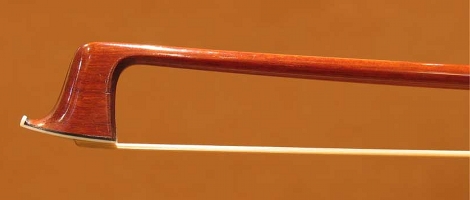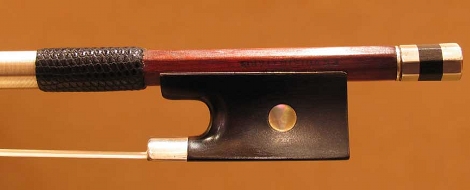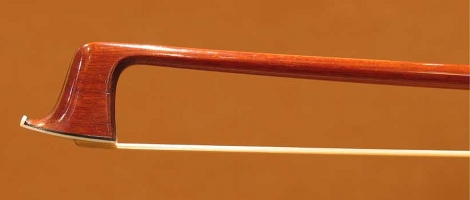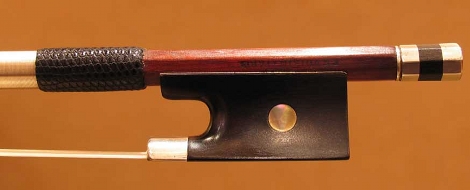FRANCOIS NICOLAS VOIRIN: THE PERFECT BALANCEThe first thing that strikes the attention when you look at Francois Nicolas Voirin's work, is with no doubt the huge development in both style and mechanic he could accomplish. Later on , a second look at his bows, reveals the enormous sensitivity that this man had for the "balance of the shape."
Violin bow F.N.Voirin 1870 ca. It is not easy to explain what I mean by "balance of the shape", I could say harmony, but it does not fit completely. There are faces that express harmony even if they are slightly disproportionate. Voirin is more style correctness and proportion, everything in him exudes a square geometry. Son of an organ builder and gardener, Nicolas Voirin and Anne Marguerite Desalle, Francois-Nicolas was born in Mirecourt, like almost all French bow makers, on October 1, 1833 and when he is twelve years old, he begins working for Jean Simon. Not much is known of his life before his departure for Paris, which took place in 1855 at the age of twenty-two years. What we do know is that the sharp eye of Jean Baptiste Vuillaume had been right once again. He starts working for him, but unlike other workers, who received a weekly wages , Voirin was paid by piece. A very great privilege considering his young age. At Vuillaume's he has the opportunity to meet and learn from the latest exponents of Peccatte's school; such as Pierre Simon and to lay the foundations of his stylistic and mechanical design, that he will transfer to many students who in turn would have become good bowmakers. Charles Peccatte , Charles-Cloud Husson, Louis Thomassin, Joseph-Alfred Lamy Père. In the fifteen years of his work by J.B., Francois-Nicolas builds a large number of bows with the support of the frog "Vuillaume" and is probably the first one to insert the micro pictures, that can observed through a lens placed in replacement of the eye, At the same time, he conceives the idea of curve and style, which will affect all the modern bowmaking , from Sartory until nowadays .In 1867, his cousin Vuillaume, during the Paris Expo introduces him as his assistant, a fact never happened before to anyone else. But despite these concessions, the partnership ends in a short time mainly due to continuous "misunderstandings", especially on wages, considering the well-known avarice of J.B. In 1870 he opens his own business at 3, rue du Bouloi, and although it continues to build Vuillaume models , he never interrupts his stylistic research. In 1872 he hires Louis Thomassin and Joseph-Alfred Lamy Père , who will remain close to him until his death. His death comes on June 4, 1885 taking him by surprise. After having worked all day to prepare the bows for the Paris Exhibition, he closes his shop at six in the evening to go to Eugène Gand and show them to him. He never reaches him. Midway he is hit by an apoplectic stroke, he will die few hours later in his bed. After his death, Louis Thomassin will continue to work for the widow Voirin for another five years. During the same period, the widow, in order to face the economic difficulties caused by the untimely death of her husband, will stamp some bows by Joseph-Alfred Lamy Père and Charles-Nicolas Bazin, with the brand "F.N. Voirin à Paris". These bows , although well made, are not comparable to the originals, and are known as "Voirin de la Veuve". (Voirin of the Widow) Mechanical and style F.N. Voirin's bow, as can be said for all the great ones, reveal some aspects of his character. He was a tough guy. He had an exceptionally fast execution, considering the level of his finish and the attention to details. Dominique Peccate was not less bold and dowry and certainly his manual skill was not inferior. The only real difference between the two Is that Dominique is the god of biowmaking, while F.N. Voirin wants to be one at all costs but he is not. His head and frogs are elegant and perfect, but this perfection betrays an awareness of inferiority. As already mentioned, Peccatte know to be God and is not interested others' opinion ; Voirin want to be told it.
The style is innovative and revolutionary, partly thanks to its taste and a little because of need. As I had anticipated, Voirin is the one who gave a turning point to the mechanics of the bow, in fact, opening the way for what will be called " Sartory curve." This type of curve, in contrast to the "Peccatte one , is moved forward, and in addition to producing changes in both mechanical and sound, it also changes the perspective of the head. I posted the photo of the bow but, unfortunately, it is not mine but comes from the network and unfortunately it is not properly done , because the stretched horsehair do not allow you to see the most important detail , i.e . the amount of the curve near the head. As you may recall (Stiffness and softness), the Sartory or modern curve , is very strong in the last third and less in the first. From the mechanical point of view, it produces a net attack at the heel, a weakening in the middle and an excess of rigidity to the head. But there are also stylistic consequences. If the curve moves forward, the head turns slightly and in doing so the hair gets too close to the stick. So I revealed the secret of heads by Voirin. So long Paolo
|
   |









